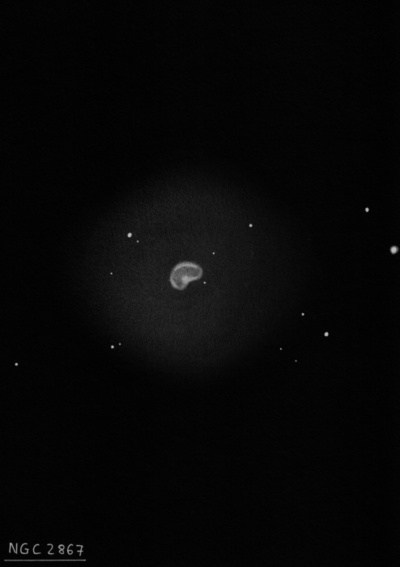
John Herschel discovered NGC 2867 = h3163 on 1 Apr 1834 (sweep 435) and called it "The finest planetary nebula I ever remember to have seen for sharpness of termination; 3" diameter; exactly R; no more haziness about them than would be about a star of the same magnitude to-night (which is a favourable one) Light, a pale white = * of 9th +/- mag. Position of companion star = 58.6° (mean) ; * = 15th mag. A very remarkable object. Showed to [assistant] Stone, who distinctly perceived the total difference of appearance between it and a star 9th mag very near it. A second companion * suspected (at about half the distance of the 1st by diagram, and at an estimated position of 330°) among multitude of large and small stars." The next night he observed it again with Thomas Maclear, astronomer at the Royal Observatory, while it was out of the meridian, to check if it might be a planet. But he noted it had "not moved perceptibly, and is therefore not a planet."
Joseph Turner, observing with the 48-inch Melbourne Telescope on 26 Feb 1878, noted the color was a pale bluish, instead of the "pale white" noted by Herschel.
400/500mm - 18" (7/8/02 - Magellan Observatory, Australia): at 171x (unfiltered) this striking planetary is bright (V = 9.7), small, very high surface brightness oval with a pale blue color. With a UHC filter, it appeared ~15"x10" and appeared like a cosmic easter egg set in a beautiful star field! Located 1.1° NE of mag 2.3 Iota Carinae (southeast star of the "False Cross").
600/800mm - 24" (4/10/08 - Magellan Observatory, Australia): beautiful, very high surface brightness blue planetary at 200x, set in a rich star field. Stunning view at 520x. The thick, oval rim is clearly brighter with a relatively small darker hole in the center! I didn't notice this structure in the 18" several years back from Australia.
Notes by Steve Gottlieb